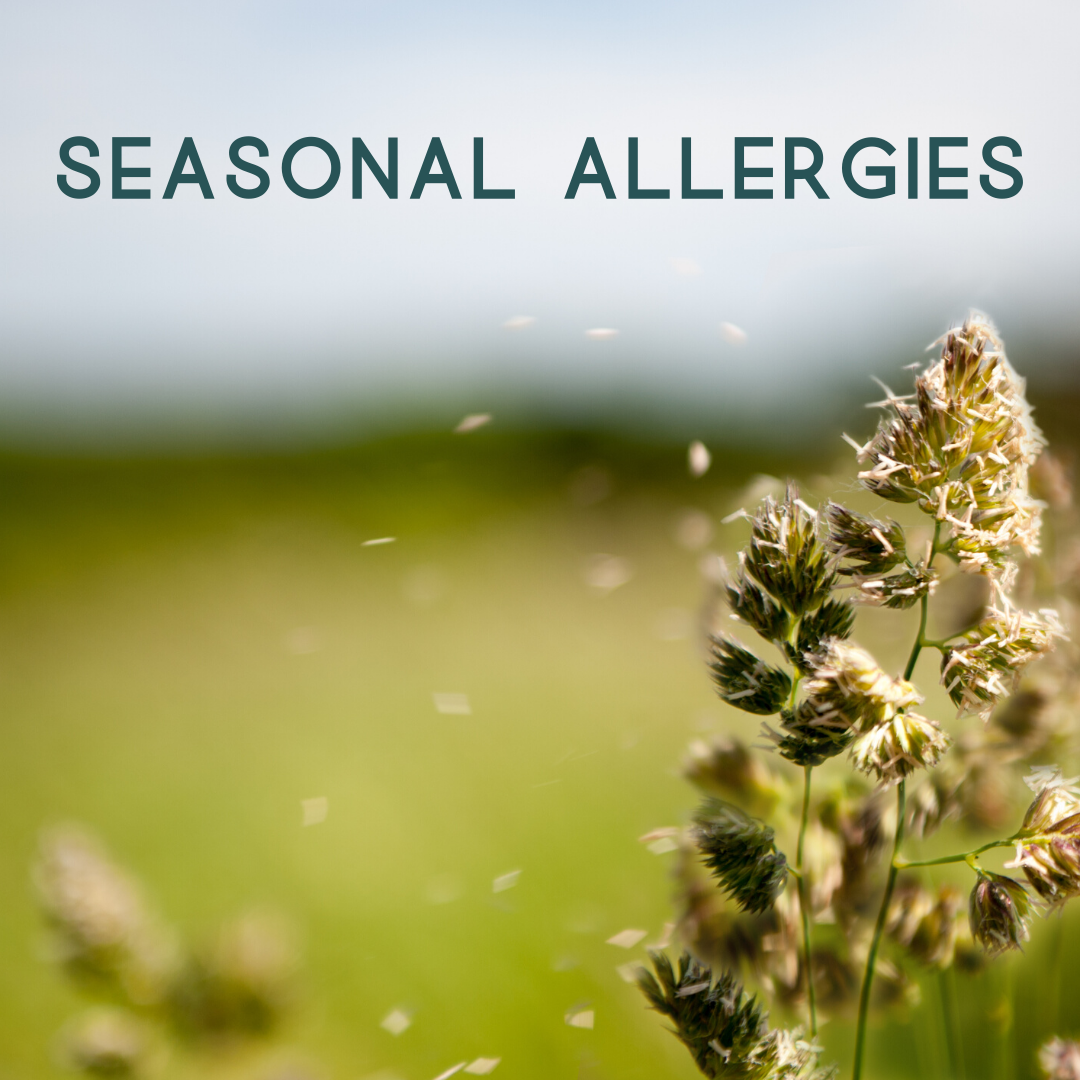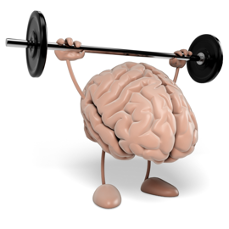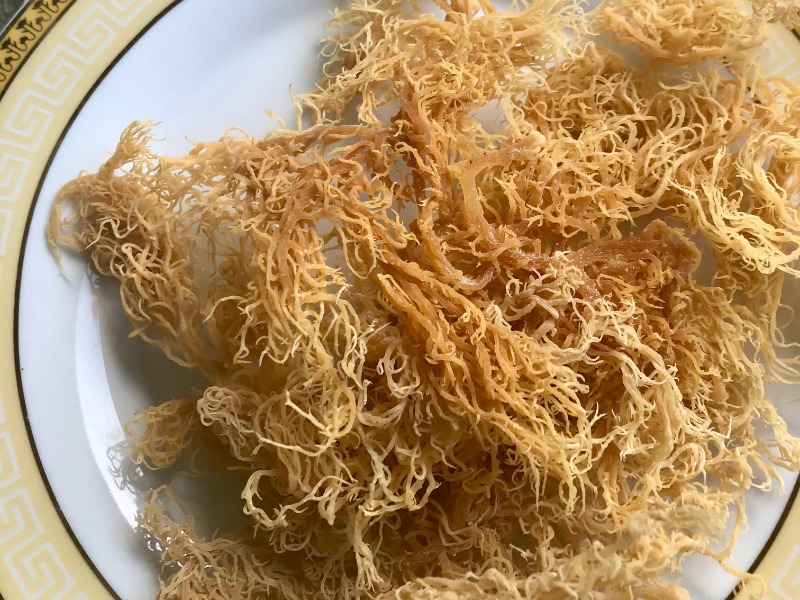
By Lyne Desforges, Holistic Nutritionist & Culinary Expert
Sea Moss: A Superfood?
I love experimenting in the kitchen and trying out new foods. After reading about how sea moss is a great thickener for homemade nut milk, I decided to order some and give it a try. I also wanted to see if all the hype about the health benefits were true.
What is it?
Sea moss is actually not a moss but an algae. It is also known as Irish moss, red algae, carrageen, or under its latin name Chondrus Crispus. It is a sea vegetable that is used in many parts of the world as a thickening agent for non-dairy milks, soups, smoothies, stews, and even skin and hair products. (5)
Sourcing it
Sea moss is found in abundance in the Carribean, as well as the North Atlantic Ocean area. Finding a clean source is important as many can contain toxic minerals such as mercury. St. Lucia seems the be one of the cleanest sources and that’s where mine came from. (1)
Is it healthy?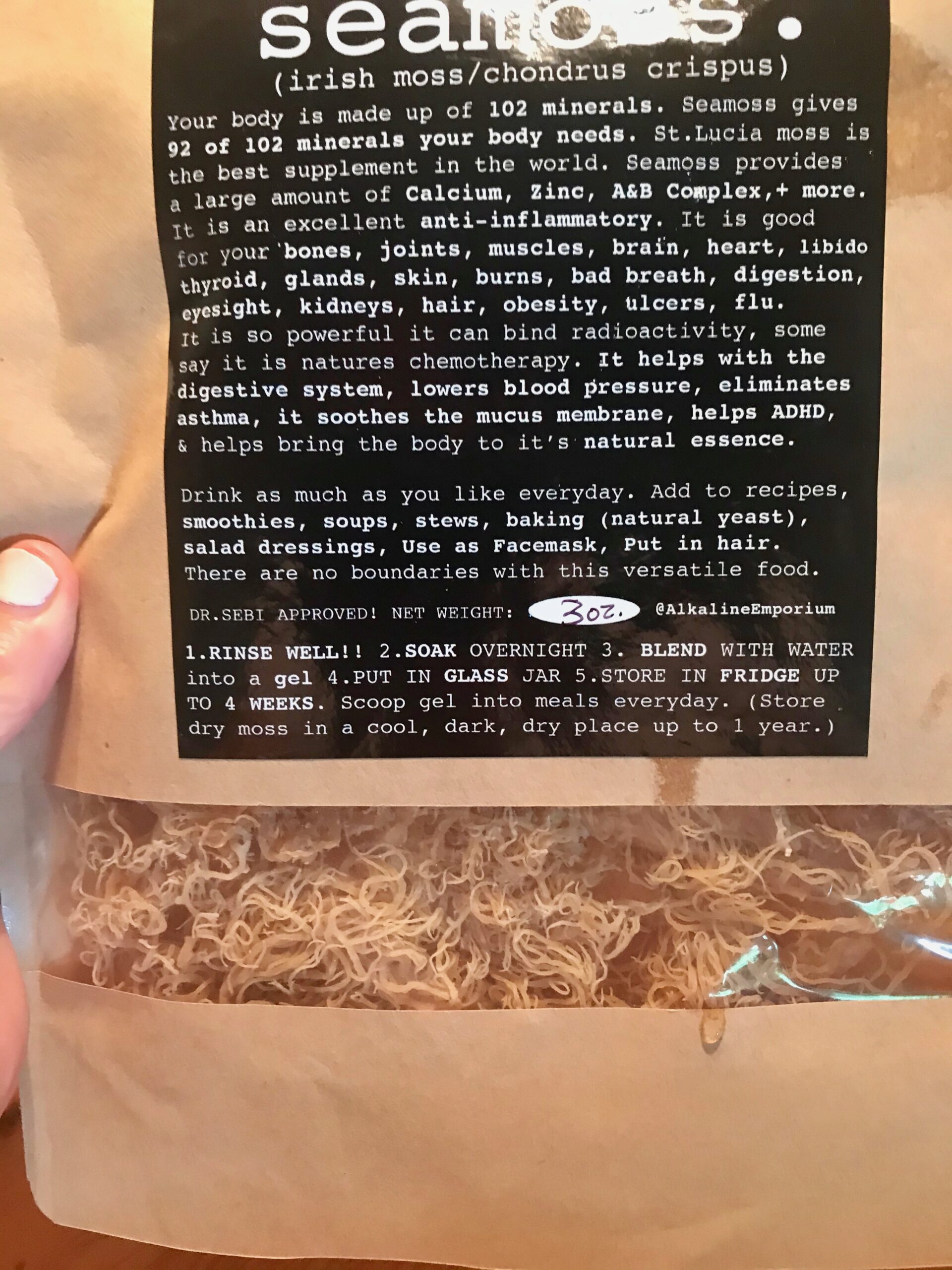
Like most sea vegetables, sea moss is rich in various minerals (calcium, zinc, selenium, potassium, etc.), A&B vitamins, iodine and antioxidants. According to the packaging label on my sea moss, it has incredible health benefits that cover pretty much every major system in the body (see photo).
Studies on the health benefits of sea moss are very limited so these claims may stem from general observations, correlations, and traditional uses over many centuries. The studies that have been done on algae were in vitro or on lab animals and they show some some evidence of the beneficial effects of sea vegetables and their components. (4)
Thyroid Health
There are two main thyroid hormones that are produced naturally in our body: tri-iodothyronine (T3) and thyroxin (T4), both of which are also found in abundance in the sea moss. Therefore, sea moss and sea vegetables are often used as a treatment for thyroid disorders. (10, 12) Because sea vegetables also contain good amounts of iodine and selenium, they help with the metabolism of thyroid hormones. Since the thyroid regulates all metabolic activities in the body, it is important to keep it healthy.
Natural Detoxifier & Cancer Fighter
Sea moss contains algin, a compound that could have a detoxifying effect because it may decrease the amount of certain heavy chemicals in the body. (2)
Another interesting study compared the effectiveness of tamoxifen (a breast cancer drug) versus an edible red algae extract in rat animals. Their findings were impressive, showing that the algae was 27% more effective than the conventional drug. There is definitely more research needed in this area but the early findings are very promising. (9, 11)
Digestive Health
 As soon as you start working with sea moss (soaking it, heating it gently), you notice its mucilaginous texture (slimy texture). This means that ingesting it will have a very healing and soothing effect for any internal mucous membrane such as the whole digestive tract and external membrane such as skin and hair. (10, 13)
As soon as you start working with sea moss (soaking it, heating it gently), you notice its mucilaginous texture (slimy texture). This means that ingesting it will have a very healing and soothing effect for any internal mucous membrane such as the whole digestive tract and external membrane such as skin and hair. (10, 13)
It also provides great prebiotic fibre to the gut, helping to nourish the good bacteria so that we can maintain good gut health and balance. (8)
Nourishment for the skin
Sea moss contains citrulline-arginine, amino acids that are important sources of nitrogen and are essential for protein and collagen synthesis. It can help protect the skin against harsh environments, and prevent and improve skin aging. (5)
Respiratory and Immune Health
Because it is so soothing and nourishing for all mucous membranes, sea moss has been used traditionally to relieve, treat or prevent any respiratory ailments such as coughs, colds, congestion, bronchitis, sore throats, etc. (6)
Certain components of sea moss have antiviral and antimicrobial properties that actually enhance the immune response in the body reducing the chances of infections. (7)
Is Carrageenan Bad?
There has been a lot of talk recently about the negative health effects of carrageenan on humans, especially cancer-causing effects. It should be noted that studies have been on lab animals and using degraded carrageenan (the kind often used in processed foods). There were no negative effects observed when using undegraded carrageenan. (3, 13) Carrageenan is one of the components that is found in sea moss. When working with the whole sea moss, I used the whole plant, not just one component. Eating the whole food is always a better option when it comes to nutrients in their most bioavailable form.
The Learning Kitchen
Sea moss is definitely an interesting food with many potential health benefits. It has been used traditionally in so many cultures all over the world to treat and heal various conditions. More research needs to be done but some of the preliminary studies are very promising. For my part, I am happy to learn more about it and add it to various recipes as I continue to experiment and discover new products in my learning kitchen.
References:
- “4oz.16.Oz St. Lucia Seamoss 100% Dried Raw Natural.” Etsy, etsy.com/ca/listing/634248837/4oz-16oz-st-lucia-seamoss-100-dried-raw.
- “Algin: Uses, Side Effects, Interactions, Dosage, and Warning.” WebMD, WebMD, webmd.com/vitamins/ai/ingredientmono-275/algin.
- Ariffin, Shahrul Hisham Zainal, et al. “Cytotoxicity Effect of Degraded and Undegraded Kappa and Iota Carrageenan in Human Intestine and Liver Cell Lines.” BMC Complementary and Alternative Medicine, BioMed Central, 17 Dec. 2014, ncbi.nlm.nih.gov/pmc/articles/PMC4320596/.
- Brown, Emma M, et al. “Seaweed and Human Health.” OUP Academic, Oxford University Press, 1 Mar. 2014, oup.com/nutritionreviews/article/72/3/205/1853561.
- Chondrus Crispus. sciencedirect.com/topics/agricultural-and-biological-sciences/chondrus-crispus.
- “Irish Moss-Chondrus Crispus.” Health Benefits, healthbenefitstimes.com/irish-moss/.
- Liu, Jinghua, et al. “Components of the Cultivated Red Seaweed Chondrus Crispus Enhance the Immune Response of Caenorhabditis Elegans to Pseudomonas Aeruginosa through the Pmk-1, Daf-2/Daf-16, and Skn-1 Pathways.” Applied and Environmental Microbiology, American Society for Microbiology, Dec. 2013, ncbi.nlm.nih.gov/pmc/articles/PMC3837755/.
- Liu, Jinghua, et al. “Prebiotic Effects of Diet Supplemented with the Cultivated Red Seaweed Chondrus Crispus or with Fructo-Oligo-Saccharide on Host Immunity, Colonic Microbiota and Gut Microbial Metabolites.” BMC Complementary and Alternative Medicine, BioMed Central, 14 Aug. 2015, ncbi.nlm.nih.gov/pmc/articles/PMC4535385/.
- “Seaweed Outperforms Chemotherapy for Breast Cancer.” NaturalHealth365, 26 Oct. 2017, naturalhealth365.com/seaweed-breast-cancer-2328.html.
- “Irish Sea Moss: Benefits, Uses and Products: ScienceFlora.” Science Flora, 6 Apr. 2020, scienceflora.org/irish-sea-moss/.
- Shamsabadi FT;Khoddami A;Fard SG;Abdullah R;Othman HH;Mohamed S; “Comparison of Tamoxifen with Edible Seaweed (Eucheuma Cottonii L.) Extract in Suppressing Breast Tumor.” Nutrition and Cancer, U.S. National Library of Medicine, ncbi.nlm.nih.gov/23441613/.
- Teas J;Braverman LE;Kurzer MS;Pino S;Hurley TG;Hebert JR; “Seaweed and Soy: Companion Foods in Asian Cuisine and Their Effects on Thyroid Function in American Women.” Journal of Medicinal Food, U.S. National Library of Medicine, ncbi.nlm.nih.gov/17472472/.
- Telpner, Meghan. “Sea Moss! Where Have You Been All My Life?” Meghan Telpner, 25 Jan. 2019, meghantelpner.com/blog/sea-moss-and-irish-moss-everything-you-need-to-know/.
Sofie Desforges-Bell | Blog | Naturopathic Medicine | Nutrition | Wellness Tips
By Dr. Sofie Desforges-Bell, Naturopathic Doctor
Seasonal Allergies (aka Hay Fever, Allergic Rhinitis)
It’s that time of year again!
Due to the current global pandemic, we have been spending a lot of time indoors. However, this is about to shift dramatically as the temperature warms up and the sun starts to shine that much brighter. Unfortunately, for some of us, that means lots of sneezing, congestion, and itching. Yes, seasonal allergies are here!
Common allergy triggers include pollen (from grasses, trees, weeds), dust mites, molds, and pets. These allergens cause an inflammatory process in the body of those who have been sensitized, releasing mediators such as histamine. This causes vasodilation of certain tissues, especially in the respiratory tract, hence the sneezing, coughing, and general congestion.
From lifestyle and dietary modifications to supplements and botanicals, naturopathic medicine provides many tools as an alternative to over-the-counter histamines. There are many health strategies you can implement to help prevent and reduce your seasonal allergy symptoms.
Identify Your Allergens
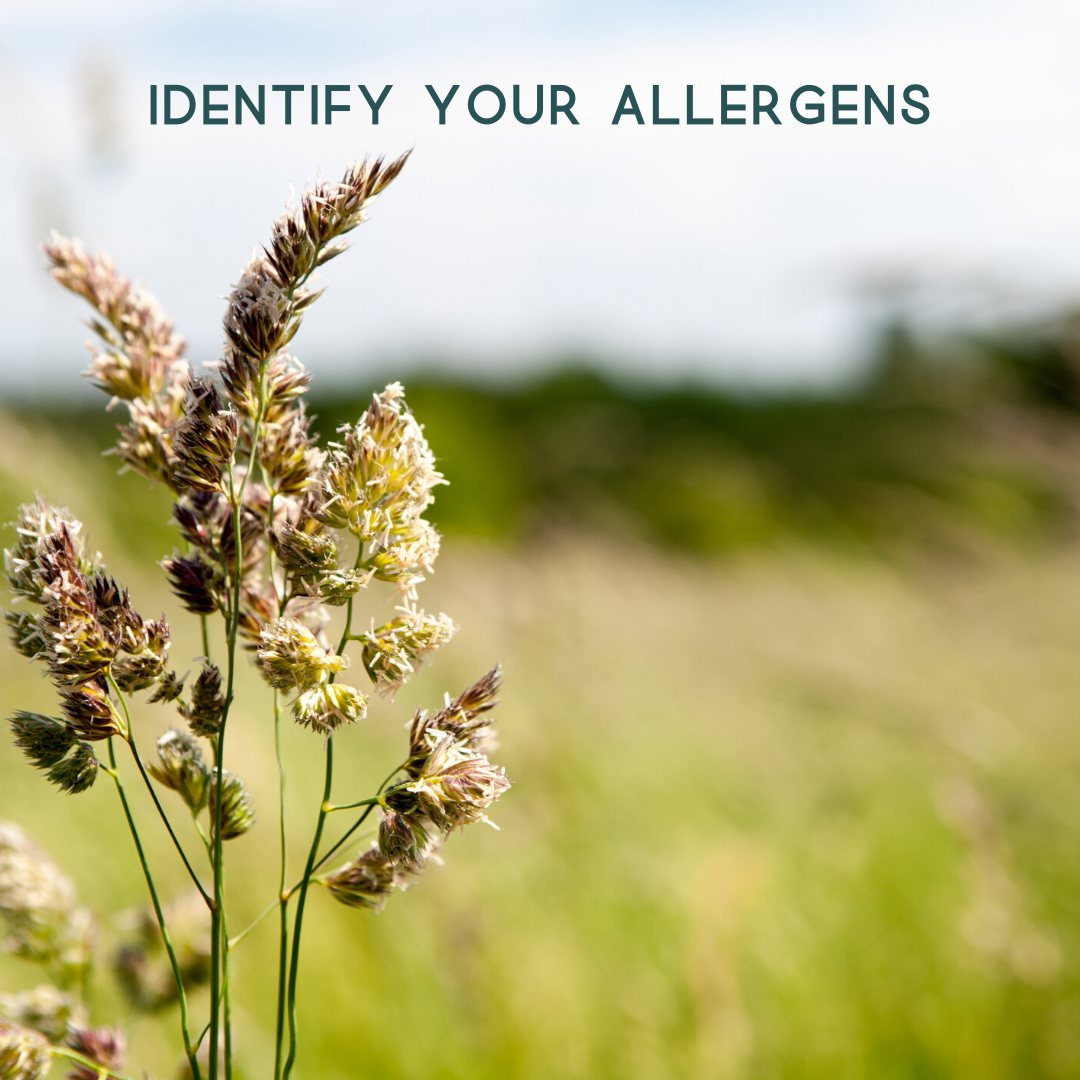
If you suspect you have allergies, I recommend you consult with your healthcare practitioner and get a referral to an allergist if need be. Getting IgE allergy testing is important to identify your allergens so you can avoid and/or remove them from your environment, as much as possible.
Some people suspect that they suffer from seasonal allergies, when in fact they may have food sensitivities. Food sensitivities are a delayed onset reaction mediated by the IgG part of the immune system versus the IgE involved in your typical hay fever picture. Having food sensitivities does also predispose you to leaky gut and increases the overall inflammation in your body. You can find out more about your own food sensitivities by doing an elimination diet or a Food Sensitivity Test.
Another important thing to rule out is histamine intolerance/overload. Some people tend to have a higher body burden of histamine either from medications, gastrointestinal issues or consuming lots of high histamine foods. If you fall in this category, you may not suffer from overt allergies, but allergens in the environment may further trigger a histamine reaction in your body leading to very similar symptoms. If we compare your body to a bucket that is already filled with water, that extra drop might just be the tipping point that causes the water to overflow. The same goes for the histamine in your body. Allergens in the environment or in your food, might just be that extra drop in the bucket that your body cannot dispose of, and cue the allergic symptoms.
The point is that you must get to the root cause of your disease in order to treat your condition appropriately and effectively and avoid merely managing symptoms with band-aid solutions such as over-the-counter anti-histamines.
Lifestyle Modifications
 Once you have identified your known allergens, the best thing you can do is to avoid them and remove them from your environment, as much as possible. In certain cases, it is impossible to avoid them completely (i.e. pollen) as you are at the mercy of Mother Nature.
Once you have identified your known allergens, the best thing you can do is to avoid them and remove them from your environment, as much as possible. In certain cases, it is impossible to avoid them completely (i.e. pollen) as you are at the mercy of Mother Nature.
There are still a few strategies you can implement that may help manage your allergic symptoms.
- Air purifier with HEPA filter
- Dehumidifier for dust mites and fungus
- Washing your clothes in hot water to destroy allergens
- Nasal irrigation: Research shows that using nasal irrigation daily can help to improve symptoms such as sneezing and itching and reduce the need for nasal corticosteroids or improve their efficacy when used in conjunction. (Hermelingmeier KE, 2012)
Nutrition
When it comes to nutrition, there is no perfect diet for everyone. It is always individualized. However, as always, it is important to eat a well-balanced diet of whole foods with lots of variety. There are still a few tricks you can try to implement if your seasonal allergies are getting the best of you.
- Low-histamine diet: Even if you aren’t a person that has histamine intolerance, you may still benefit from avoiding certain foods that are high in histamine during this time of year to minimize your symptoms. It is hard to navigate through all the information on Internet relating to histamine. Fortunately, our Registered Holisitc Nutritionist Lyne, has compiled the information in her blog “Histamine in Foods“. You can also purchase our 4-week Low-Histamine Menu to get you started. Contact us for more information.
- Increase omega-3/omega-6 ratio: Omega-3s and Omega-6s are both essential polyunsaturated fatty acids. We often focus on increasing our levels of omega-3 fatty acids, through food and supplementation, because these have a known anti-inflammatory effect. Omega-6s tend to be more pervasive in our food sources already, so we don’t need to focus so much on attaining our essential levels of these fatty acids. They also can become pro-inflammatory in excess, so the idea is to maintain the proper ratio of omega-3s to omega-6s. The overall goal is to reduce inflammation in the body because it can often contribute to many allergic symptoms such as swelling, itching, and runny noses. (Okamoto) Your best sources of Omega-3 foods are fish & seafood (especially cold-water fatty fish), and nuts & seeds (especially flaxseeds and walnuts).
- Spirulina: this blue-green algae can be consumed as part of your diet or taken as a supplement. Spirulina naturally grows in salt water and in some fresh water lakes. It is a great source of minerals that is well ingested when taken orally. You do have to be wary of sourcing though as some natural sources may be contaminated. Research is starting to become more frequent with this algae for its benefits on the immune system, inflammation and infections. Although the evidence remains insufficient at this time, some preliminary research has shown that taking 2g of spirulina daily for 6 months has improved self-reported scores of sneezing, nasal discharge and congestion in adults with allergic rhinitis. (Cingi, 2008)
Botanicals*
 Botanicals can be very effective and therapeutic in the treatment of many conditions and symptoms. They are great to help nudge the body in the direction of healing and offer more than one therapeutic action which aids to support various body systems.
Botanicals can be very effective and therapeutic in the treatment of many conditions and symptoms. They are great to help nudge the body in the direction of healing and offer more than one therapeutic action which aids to support various body systems.
- Butterbur: Also known as Petasites hybridus, this shrub has some good evidence supporting its role in managing symptoms of hay fever, mostly nasal symptoms such as congestion. Interestingly, some research showed that a standardized extract of petasin (the active ingredient of the plant), might be just as effective as cetirizine (Zyrtec) or fexofenadine (Allegra), which are typical over-the-counter anti-histamines. (Schapowal, 2002) (Lee, 2004)
- Nettle (Urtica dioica): I love recommending organic nettle tea as part of the allergy prevention protocol for patients around this time of year. In combination with vitamin C and quercetin (see below for more information on these nutrients), it can be quite effective. Nettle is a very hearty and nutritious plant that has some preliminary evidence supporting its use at the first sign of symptoms. It is very safe for most, other than pregnant patients and those who are breastfeeding, and is easy to add to your daily routine as you can sip on the tea continuously throughout the day. (Mittman, 1990)
Supplements*
Supplements can be a great addition to your seasonal allergy protocol and I love using the triad of nettle tea, vitamin C and quercetin as a natural prevention.
- Vitamin C: As humans, we don’t make our own vitamin C like most other mammals, and therefore it is essential that we get it from our diet. We get a lot of it from fruits and vegetables, however for a more therapeutic effect supplementation is often necessary to achieve the higher dose and concentration required. Although most of the evidence for hay fever and vitamin C is insufficient, a few studies have shown promise. One in particular showed that a single dose of vitamin C of 2g reduces the airway response when exposed to histamine in the environment for about 40% of adults with allergic rhinitis. (Bucca, 1990)
- Quercetin: Quercetin is a flavonoid that is naturally occurring in some foods such as onions, apples, and berries as well as in several herbs. Quercetin is thought to be a natural anti-histamine because of its ability to inhibit the release of histamine from mast cells in the body, a great alternative to over-the-counter products. (Otsuka, 1995) However more research is needed on its effect for the relief of allergic symptoms.
Book A Visit
As you can see, naturopathic medicine offers many complimentary and alternative natural treatment options not only to treat allergic symptoms but also to prevent their onset at this time of year. If you would like to learn more what naturopathic medicine can do for you and your allergies, book in for a Free Naturopathic Meet & Greet (15-min). I am currently continuing to offer my services virtually for patients, by phone and video and we hope to reopen the clinic soon for those of you requiring in-person services.
* Please note that although botanicals and other supplements may be more natural than most pharmaceuticals, they nonetheless have very therapeutic effects and can interact with other supplements, herbs, and/or medications. Some botanicals may be unsafe to use with certain health conditions as well. Always consult your healthcare practitioner before starting, changing, or stopping any supplement or herbal product.
References
Bucca, C. R. (1990). Effect of vitamin C on histamine bronchial responsiveness of patients with allergic rhinitis. Ann Allergy, 65:311-4.
Cingi, C. C.-D. (2008). The effects of spirulina on allergic rhinitis. . Eur Arch Otorhinolaryngol., 265(10):1219-23.
Hermelingmeier KE, W. R. (2012). Nasal irrigation as an adjunctive treatment in allergic rhinitis: a systematic review and meta-analysis. Am J Rhinol Allergy, 26(5):e119-25.
Lee, D. G. (2004). A placebo-controlled evaluation of butterbur and fexofenadine on objective and subjective outcomes in perennial allergic rhinitis. Clin Exp Allergy, 34:646-9.
Mittman, P. (1990). Randomized, double-blind study of freeze-dried Urtica dioica in the treatment of allergic rhinitis. Planta Med., 56:44-7.
Okamoto, M. M. (n.d.). Effects of dietary supplementation with n-3 fatty acids compared with n-6 fattys acids on bronchial asthma.
Otsuka, H. I. (1995). Histochemical and functional characteristics of metachromatic cells in the nasal epithelium in allergic rhinitis: studies of nasal scrapings and their dispersed cells. J Allergy Clin Immunol, 96:528-36.
Schapowal, A. (2002). Randomised controlled trial of butterbur and cetirizine for treating seasonal allergic rhinitis. BMJ, 324:144-6.
Schapowal, A. (2005). Treating intermittent allergic rhinitis: a prospective, randomized, placebo and antihistamine-controlled study of Butterbur extract Ze 339. Phytother Res, 19:530-37.
By Lyne Desforges, R.H.N.
 Allergy season is here and you are wondering why your symptoms are worse this year? It could have nothing to do with the amount of pollen in the air and a lot more to do with what you are eating. Yes, histamine in food may be adding to your histamine load and your body cannot handle it. You may have become histamine intolerant (8).
Allergy season is here and you are wondering why your symptoms are worse this year? It could have nothing to do with the amount of pollen in the air and a lot more to do with what you are eating. Yes, histamine in food may be adding to your histamine load and your body cannot handle it. You may have become histamine intolerant (8).
What Is Histamine?
Histamine is a brain chemical (or neurotransmitter) that is released in the body, as part of the inflammatory response. (5) When we come in contact with an allergen, histamine is like the first responder of the immune system, working at getting rid of the foreign invader, whether it is a virus, bacteria, or an allergen. (6)
Histamine is also essential for the regulation of stomach acid (12), the permeability of blood vessels, muscle contractions (8), brain function and neuropathic pain relief. (9)
What is Histamine Intolerance?
If there is too much histamine circulating in the body and the body cannot break it down quickly enough, then typical allergy symptoms start to appear: red or itchy eyes, hives, rashes, swelling, low or high blood pressure, heart racing, chest pain, nasal congestion, headaches, fatigue, irritability, digestive issues, nausea, vomiting, dizziness, anxiety. (8)
The role of Diamine Oxydase (DAO)
Diamine oxydase (DAO) is one of the enzymes responsible for the breakdown of histamine in the body. If you have a deficiency in this enzyme, then you can have a buildup of histamine. (8) Certain medications, digestive disorders, and foods may block proper function of DAO as well.
The Histamine Bucket
 To better understand the effect of histamine in food, let’s use Dr. Joneja’s analogy of a bucket of water (2). Let’s compare histamine in our body to water in a bucket.
To better understand the effect of histamine in food, let’s use Dr. Joneja’s analogy of a bucket of water (2). Let’s compare histamine in our body to water in a bucket.
- We start with a little bit of water in the bucket because that’s the essential amount of histamine we need for our body to function properly.
- If you consume foods that are inflammatory for you, then that adds water (or histamine) to your bucket.
- If you have seasonal allergies, environmental allergies, or food intolerances, and you are exposed to the allergen (pollen, dander, plants, food, etc.), then you are producing more histamine and adding more water to that bucket.
- If you have a DAO enzyme deficiency, then your bucket will fill up that much faster because your body is not able to breakdown the excess histamine.
- If you consume a meal made of food that are rich in histamines (i.e. cheese, wine, avocados, strawberries, kimchi, etc.), then you continue to fill your bucket. If your histamine level was already high because of your allergies, then the bucket overflows, and that’s when symptoms appear.
The top of the bucket is a person’s tolerance level. Everyone’s tolerance will be different depending on the factors mentioned above. Please note that histamine levels in your body vary all the time because of what you are exposed to and what you eat. Therefore, during pollen allergy season, you may find yourself reacting to foods (usually high-histamine foods) that you would not normally react too. That’s because your bucket is already too full.
Where does histamine come from?
You either make it (intrinsic) or ingest it (extrinsic). (3)
Intrinsic sources:
1. Our body makes histamine naturally to perform certain essential functions in the body.
2. Intestinal bacteria can make it from undigested protein in the bowels.
Extrinsic sources:
1. Some foods naturally contain high levels of histamine, especially aged or fermented foods.
2. Certain manufactured foods also contain high levels of histamine because of the additives it contains.
3. Certain foods are histamine releasers. They encourage the release of histamine from mast cells in the body.
4. Certain foods block the activity of the DAO enzyme, therefore histamine will not be broken down efficiently.
Histamine in Your Food
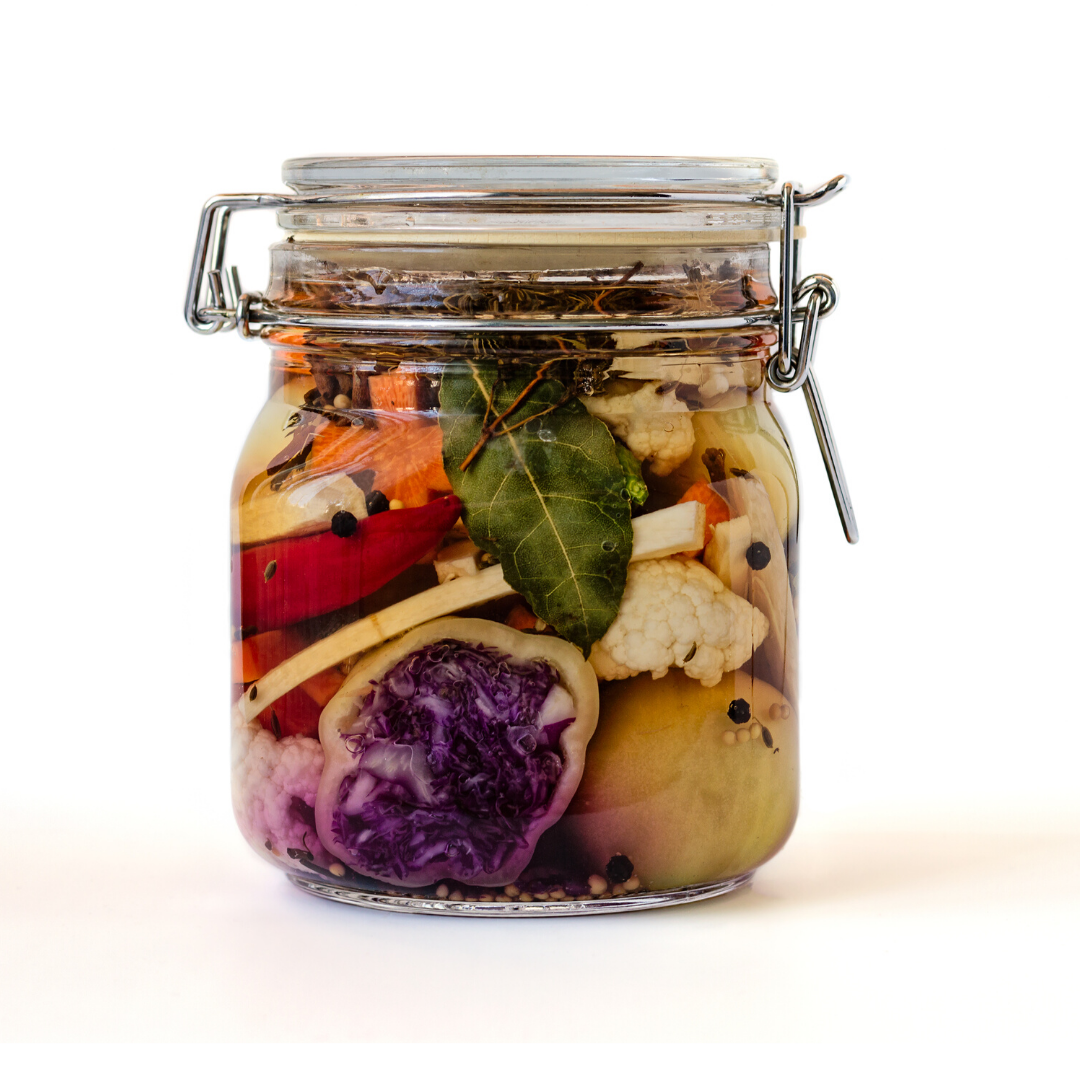 Histamine is produced when bacteria or yeast converts histidine (an amino acid) into histamine (a neurotransmitter). (7) Since proteins are made up of amino acids, foods that contain protein can all make histamine under certain conditions. In general, aged and fermented foods will contain the highest levels of histamine. (13)
Histamine is produced when bacteria or yeast converts histidine (an amino acid) into histamine (a neurotransmitter). (7) Since proteins are made up of amino acids, foods that contain protein can all make histamine under certain conditions. In general, aged and fermented foods will contain the highest levels of histamine. (13)
It is important to note that histamine levels in food will vary depending on how fresh it is, how it was transported, how it was stored, and how it was processed. (8, 14) For example, fresh fish that is gutted and frozen immediately after being caught will be low in histamine. If that same freshly caught fish is left un-gutted for a while, its histamine levels will automatically increase as bacteria multiplies in the gut and converts histidine found in the flesh of the fish into histamine.
Research on histamine content in foods is sparse and very variable because of the factors mentioned above. However, many authors (2, 4, 14) agree on some of the basic ones. You can use our Histamine Food Chart for a more complete list of foods to avoid and foods that are safe to eat.
- Histamine-rich foods: these included all fermented foods, aged foods, smoked foods, some ripened fruits and vegetables.
- Foods with histamine releasing capacities: this includes many food additives as well as certain fruits and vegetables.
- Foods that block the activity of the DAO enzyme: mostly alcohol, tea (black and green), and sports drinks.
For a more complete list, please use our Histamine Food Chart.
Food preparation and storage
When choosing meat and fish, always buy as fresh as possible and use immediately or freeze it until ready to use. If buying frozen fish, look for the label FAS (frozen-at-sea) (13). Freezing slows down or prevents the increase of histamine (10) in food so whatever you are not going to eat right now, freeze it. That includes leftovers or any cooked food.
The way you cook your food can also increase the levels of histamine. Frying and grilling foods increases histamine levels in foods (1), but boiling has little influence or can even decrease it.
Adopting a Low-Histamine Diet
If you have intense seasonal allergies, you may want to follow a low-histamine diet for a few weeks. This would alleviate the histamine burden on your body. It may be difficult to do on your own, so reach out to us if we can help with meal planning. If you would like to have more support, feel free to contact our naturopath Dr. Sofie or our nutritionist Helen. They will be happy to support you with your health goals.
References:
-
Chung BY;Park SY;Byun YS;Son JH;Choi YW;Cho YS;Kim HO;Park CW; “Effect of Different Cooking Methods on Histamine Levels in Selected Foods.” Annals of Dermatology, U.S. National Library of Medicine, pubmed.ncbi.nlm.nih.gov/29200758/
-
“Dr Janice Joneja Histamine Intolerance Interview Transcript.” Healing Histamine, 4 Apr. 2018, healinghistamine.com/dr-janice-joneja-histamine-intolerance-interview-transcript/
-
“FAQs and Fact Sheets: Histamine Intolerance.” Vickerstaff Health Services, allergynutrition.com/faqs-fact-sheets/.
-
Food Intolerance Network. “Histamine Intolerance – The Food List.” Food Intolerance Network, food-intolerance-network.com/food-intolerances/histamine-intolerance/food-list-with-histamine-levels.html
-
“Histamine.” Wikipedia, Wikimedia Foundation, 15 Apr. 2020, en.wikipedia.org/wiki/Histamine
-
“Histamine: Definition, Effects & Role.” com, 13 October 2016, study.com/academy/lesson/histamine-definition-effects-role.html
-
Landete, J.M., et al. “Biogenic Amine Production by Lactic Acid Bacteria, Acetic Bacteria and Yeast Isolated from Wine.” Food Control, Elsevier, 10 Jan. 2007, sciencedirect.com/science/article/abs/pii/S0956713507000059
-
Maintz, et al. “Histamine and Histamine Intolerance.” OUP Academic, Oxford University Press, 1 May 2007, academic.oup.com/ajcn/article/85/5/1185/4633007
-
Obara, Ilona L., et al. “Histamine, Histamine Receptors and Neuropathic Pain Relief .” British Pharmacological Society | Journals, John Wiley & Sons, Ltd, 7 June 2019, bpspubs.onlinelibrary.wiley.com/doi/full/10.1111/bph.14696
-
P;, Rossano R;Mastrangelo L;Ungaro N;Riccio. “Influence of Storage Temperature and Freezing Time on Histamine Level in the European Anchovy Engraulis Encrasicholus (L., 1758): A Study by Capillary Electrophoresis.” Journal of Chromatography. B, Analytical Technologies in the Biomedical and Life Sciences, U.S. National Library of Medicine, pubmed.ncbi.nlm.nih.gov/16260192/
-
Pinzer, T C, et al. “Circadian Profiling Reveals Higher Histamine Plasma Levels and Lower Diamine Oxidase Serum Activities in 24% of Patients with Suspected Histamine Intolerance Compared to Food Allergy and Controls.” Allergy, John Wiley and Sons Inc., Apr. 2018, ncbi.nlm.nih.gov/pmc/articles/PMC5947167/
-
Prinz C;Zanner R;Gerhard M;Mahr S;Neumayer N;Höhne-Zell B;Gratzl M; “The Mechanism of Histamine Secretion From Gastric Enterochromaffin-Like Cells.” The American Journal of Physiology, U.S. National Library of Medicine, pubmed.ncbi.nlm.nih.gov/10564076/
-
Richter, Amy. “Low Histamine Diet 101: What to Eat, What to Avoid, and Why.” Functional Nutrition Answers, 15 Dec. 2019, functionalnutritionanswers.com/low-histamine-diet-101-what-to-eat-what-to-avoid-and-why/
-
Vivienne, et al. “Histamine & Food: The Evidence.” Mast Cells & Collagen Behaving Badly, 31 Dec. 2018, mastcellblog.wordpress.com/food/evidence/
Lyne Desforges | Blog | Naturopathic Medicine | Nutrition | Wellness Tips
By Lyne Desforges, Registered Holistic Nutritionist & Culinary Expert
Time to Reduce Inflammation!
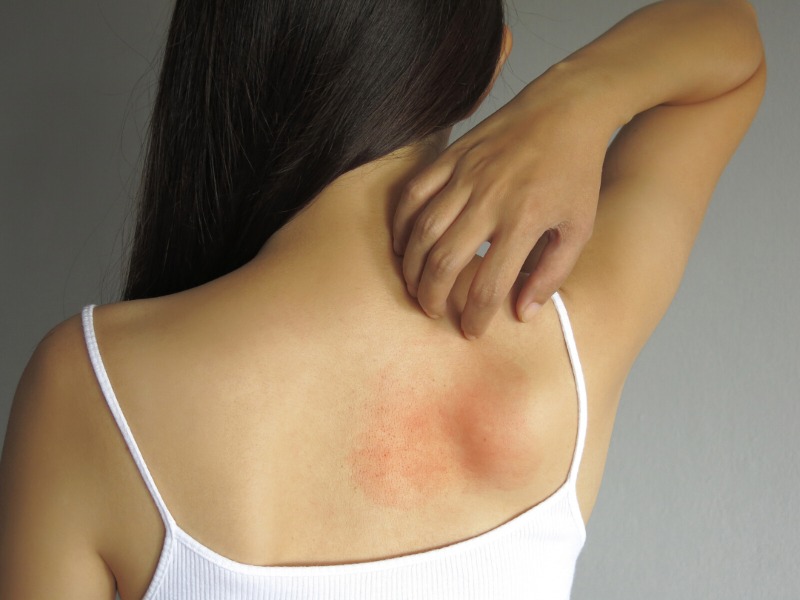 For the past ten springs & summer seasons, I have had a bad case of rashes all over my body. According to dermatologists, this is “contact dermatitis“, a condition where the skin is in contact with an allergen and an irritation occurs. Even though this made sense somewhat, I was still dumbfounded when the rashes would appear in odd places on my body and at odd times of the year (in March?). So what the heck was going on? Not only that, but my whole body started to ache more. I just felt like I was in a constant state of inflammation. This is when our clinic’s naturopath, Dr. Sofie, suggested I do a food intolerance test, and that I reduce histamine-rich foods in my diet. With her support and guidance, I began to reduce inflammation through food elimination, a low-histamine diet, and helpful supplements. Here are the 5 key steps that helped me get back up the slope of health.
For the past ten springs & summer seasons, I have had a bad case of rashes all over my body. According to dermatologists, this is “contact dermatitis“, a condition where the skin is in contact with an allergen and an irritation occurs. Even though this made sense somewhat, I was still dumbfounded when the rashes would appear in odd places on my body and at odd times of the year (in March?). So what the heck was going on? Not only that, but my whole body started to ache more. I just felt like I was in a constant state of inflammation. This is when our clinic’s naturopath, Dr. Sofie, suggested I do a food intolerance test, and that I reduce histamine-rich foods in my diet. With her support and guidance, I began to reduce inflammation through food elimination, a low-histamine diet, and helpful supplements. Here are the 5 key steps that helped me get back up the slope of health.
Step 1 – Reduce/Eliminate Inflammatory Foods
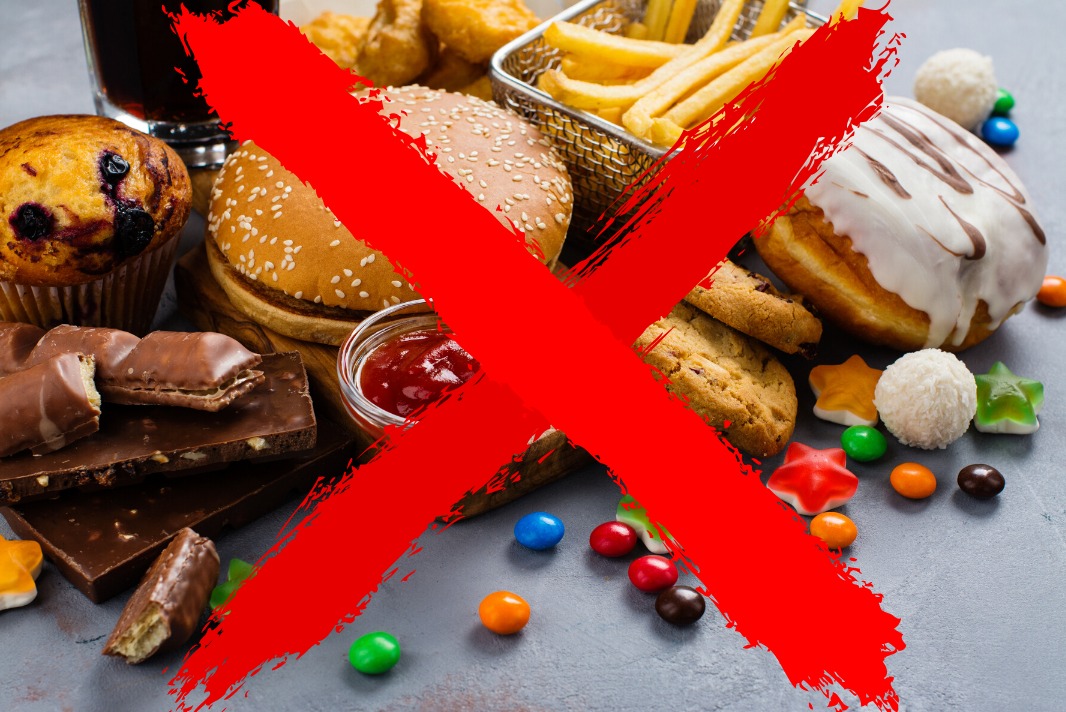 My basic food philosophy has always been: “Eat Real Food, Know Where It’s Coming From, Prepare It With Care”.
My basic food philosophy has always been: “Eat Real Food, Know Where It’s Coming From, Prepare It With Care”.
Avoiding the typical inflammatory foods has been an important part of my health journey. We all know what those are: processed foods, junk foods, trans fats, refined sugars and carbs, food additives and preservatives. I have also reduced or eliminated gluten and dairy. That was already a good start, but I still found that my body was inflamed and that’s when I discovered that not all healthy foods are healthy for me!
Step 2 – Do a Food Intolerance Test
 Everyone is biologically different and one particular food could be very beneficial to one person but harmful to another. By doing a Food Intolerance Test, you get an overall picture of what foods to avoid and what foods are safe. With that list in mind, you eliminate the harmful foods for a minimum of three weeks. Then you start reintroducing them one a time every 3-4 days and notice any effects on your body. With the support of our clinic’s naturopath, Dr. Sofie, I took a blood test to determine my inflammatory foods. I was astounded to find out that healthy foods like mushrooms, flaxseeds, egg whites, and peas could be increasing inflammation in my body. Food intolerances are very different from food allergies because they don’t always cause immediate reactions or symptoms in the body. You can read more about it in Dr. Sofie’s blog on seasonal allergies.
Everyone is biologically different and one particular food could be very beneficial to one person but harmful to another. By doing a Food Intolerance Test, you get an overall picture of what foods to avoid and what foods are safe. With that list in mind, you eliminate the harmful foods for a minimum of three weeks. Then you start reintroducing them one a time every 3-4 days and notice any effects on your body. With the support of our clinic’s naturopath, Dr. Sofie, I took a blood test to determine my inflammatory foods. I was astounded to find out that healthy foods like mushrooms, flaxseeds, egg whites, and peas could be increasing inflammation in my body. Food intolerances are very different from food allergies because they don’t always cause immediate reactions or symptoms in the body. You can read more about it in Dr. Sofie’s blog on seasonal allergies.
Step 3 – Reduce Histamine-Rich Foods
Histamine is a brain chemical (a neurotransmitter) that is released in the body, as part of the inflammatory response. When we come in contact with an allergen, histamine is like the first responder of the immune system, working at getting rid of the foreign invader (virus, bacteria, allergen, etc.).
When we come in contact with an allergen, histamine is like the first responder of the immune system, working at getting rid of the foreign invader (virus, bacteria, allergen, etc.).
The problem occurs when there is too much histamine circulating in the body and the body cannot break it down quickly enough. That’s when typical allergy symptoms start to appear: red or itchy eyes, hives, rashes, swelling, nasal congestion, headaches, fatigue, irritability, digestive issues, nausea, vomiting, etc.
What I didn’t realize was that many of the healthy foods I was eating were rich in histamine, thus adding to the overall histamine load in my body: i.e. fermented foods, avocados, spinach, strawberries, tomatoes, lemons, etc. For a complete list of foods to avoid, check out my latest blog “Histamine in Foods: How It Could Aggravate Your Allergy Symptoms”. Following a low-histamine diet has helped immensely in reducing and even eliminating my rashes.
Step 4 – Eliminate Toxins
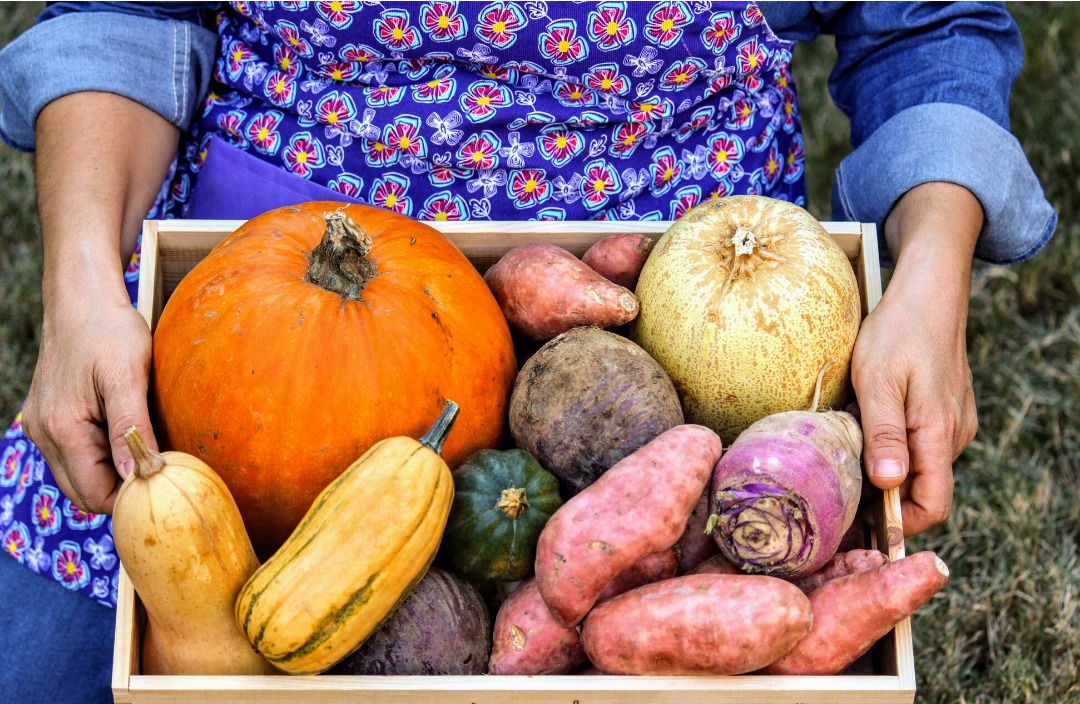 Give your liver some love by reducing its toxic load. Avoiding all external and internal sources of toxins has been my goal for the past two years. I have replaced most of my plastic containers with glass or steel. Using a refillery like Park Market & Refillery has been a great help. I try to buy organic as much as possible and have a CSA (Community Supported Agriculture) share with Plan B Organics. And I have cleaned up my cleaning. My household cleaning products and personal care products are mostly natural and toxic free. I adopted a daily meditation and gratitude practice to reduce my mental and spiritual toxicity as well. All these have helped reduce inflammation in my body.
Give your liver some love by reducing its toxic load. Avoiding all external and internal sources of toxins has been my goal for the past two years. I have replaced most of my plastic containers with glass or steel. Using a refillery like Park Market & Refillery has been a great help. I try to buy organic as much as possible and have a CSA (Community Supported Agriculture) share with Plan B Organics. And I have cleaned up my cleaning. My household cleaning products and personal care products are mostly natural and toxic free. I adopted a daily meditation and gratitude practice to reduce my mental and spiritual toxicity as well. All these have helped reduce inflammation in my body.
Step 5 – Supplement with Helpful Nutrients
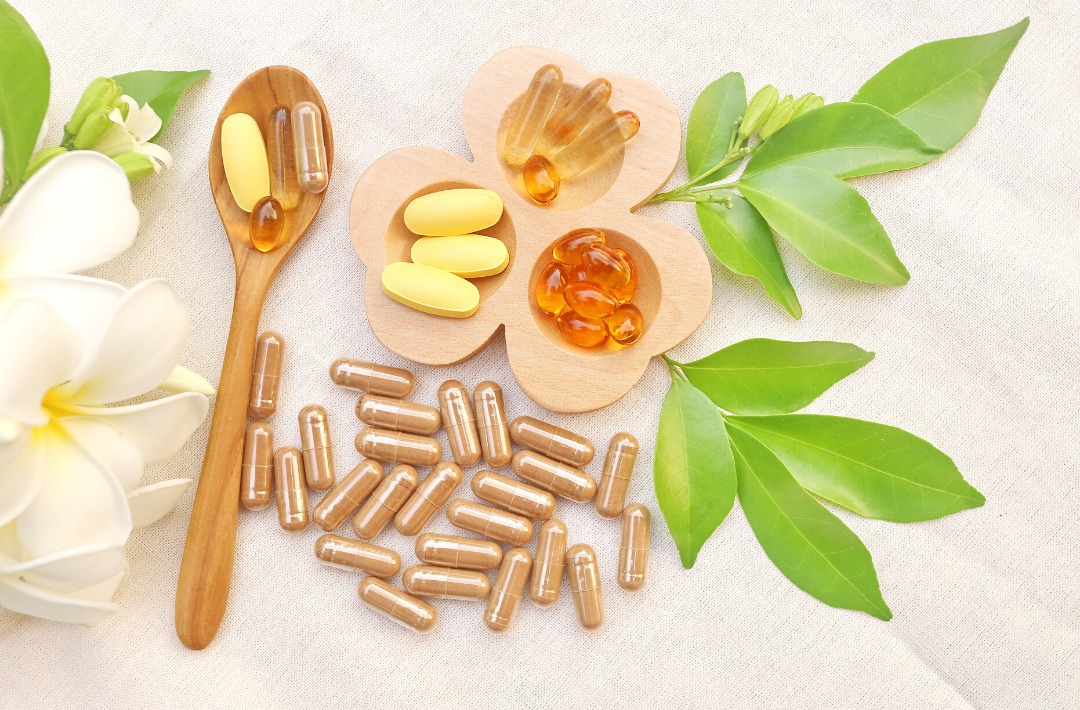 With the help of our clinic’s naturopath Dr. Sofie, I started to integrate more healing nutrients to support my journey to reduce my overall inflammatory state. Adding quercetin, vitamin C, and nettle tea have helped during allergy season to reduce the intensity and frequency of my rashes. Taking collagen and curcumin have helped with my overall aches and pain. Lastly, working on my digestion and gut healing with digestives enzymes and glutamine, has ensured that my body absorbs all the healthy nutrients from the foods I am eating.
With the help of our clinic’s naturopath Dr. Sofie, I started to integrate more healing nutrients to support my journey to reduce my overall inflammatory state. Adding quercetin, vitamin C, and nettle tea have helped during allergy season to reduce the intensity and frequency of my rashes. Taking collagen and curcumin have helped with my overall aches and pain. Lastly, working on my digestion and gut healing with digestives enzymes and glutamine, has ensured that my body absorbs all the healthy nutrients from the foods I am eating.
Remember to always consult with your healthcare practitioner before starting to take any supplements.
Health is a Journey
 The path to health evolves and shifts constantly. You are either moving up or down the slope of health and the more you can do to help reduce inflammation in the body, the better. Reducing inflammation in the body takes commitment. Like everyone, I have good days and I have bad days. My diet is not perfect but at least I am more aware of the effects of certain foods on my body, my energy levels, my mood, and my overall vitality. I am happy to report that I have not had any rashes this year, and I feel a reduction in aches and pain in my body. It’s hard to do it all on your own. With the help of a naturopath or a nutritionist, you too can reduce inflammation in your body and start feeling more like your true vibrant self so you can enjoy life to the fullest.
The path to health evolves and shifts constantly. You are either moving up or down the slope of health and the more you can do to help reduce inflammation in the body, the better. Reducing inflammation in the body takes commitment. Like everyone, I have good days and I have bad days. My diet is not perfect but at least I am more aware of the effects of certain foods on my body, my energy levels, my mood, and my overall vitality. I am happy to report that I have not had any rashes this year, and I feel a reduction in aches and pain in my body. It’s hard to do it all on your own. With the help of a naturopath or a nutritionist, you too can reduce inflammation in your body and start feeling more like your true vibrant self so you can enjoy life to the fullest.
Feel free to contact us at the C’est La Vie Wellness if you need help and guidance in achieving your health and wellness goals. If you would like to do a Food Intolerance Test or purchase any of the supplements suggested, please contact our naturopath, Dr. Sofie.
Lyne Desforges | Blog | Naturopathic Medicine | Nutrition | Wellness Tips
By Lyne Desforges, R.H.N.
Living with Dehydration
 Every living being needs water for their survival. It is indeed, the essence of life. However, as humans, we often neglect this essential nutrient in favour of coffee or alcohol. According to doctors, 75% of Americans may be suffering from chronic dehydration?
Every living being needs water for their survival. It is indeed, the essence of life. However, as humans, we often neglect this essential nutrient in favour of coffee or alcohol. According to doctors, 75% of Americans may be suffering from chronic dehydration?
Did you know that exercising in hot, humid weather could make you dehydrated in as little as 30 minutes?
An average adult loses approximately 10 cups of water every day, just by breathing, sweating and urinating. Some symptoms of dehydration are thirst, headache, low urine output, dizziness, lethargy, constipation and dark yellow urine.
Adopting healthy habits can start with something as simple as adding more water to your daily routine. You will be surprised at how much better you will feel.
We Are Basically Made of Water
Did you know that up to 60% of the human body is made up of water? According to the USGS Water Science School, the brain and heart are made up of 73% water, the lungs are 83% water, the skin is 64% water, muscles and kidneys are 79%, and even the bones are watery at 31%. So drink up! Your body will love you for it.
How Much Water Do You Need?
According to the Mayo clinic, men need 3 litres of fluid per day while women need 2.2 litres. These amounts will vary according to the person’s size, age, health, activity level and the weather. Fluid intake can be from water, juices, herbal teas, soups, smoothies, and food. Remember that coffee and alcohol don’t count as they are dehydrating and require even more fluid to compensate!
Here is a quick way to calculate your water needs:
Take your weight in pounds and divide it by 2. The result is the # of fluid ounces you need per day.
5 Reasons Why You Need to Drink Water
-
Not just a pretty face:
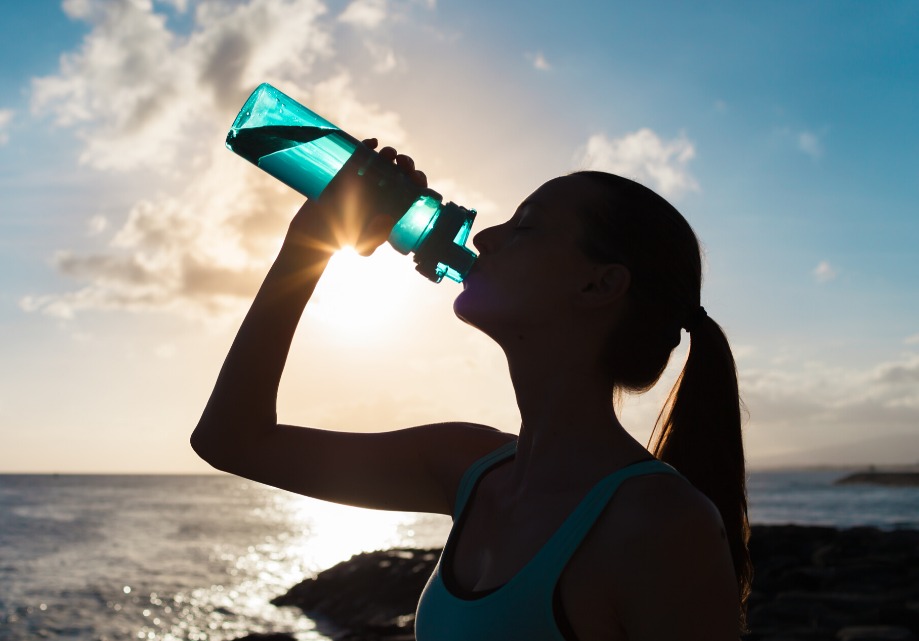
Defy aging by keeping your skin plump and moist… and keep them guessing! -
A spring in your step:
Water lubricates joints and moistens tissues making every step a joyous event. -
Fit and trim:
Water boosts your metabolism and may curb hunger. Bye bye cravings! -
Clean lean machine:
Get rid of toxins by promoting good elimination and keep your kidneys happy. -
Whiz kid:
Water increases your energy and your cognitive ability, so get out that Trivia game and dazzle everyone with your happy brain!
3 Tips to Increase Your Daily Intake
-
Tip #1:
Fill a big jug of water in the morning and aim to drink it all by the end of the day. -
Tip #2:
Put elastics around your water bottle. If you aim to drink 2 litres and your water bottle contains 500 ml, then put 4 elastics around it. Every time you refill the bottle, remove one elastic. -
Tip #3:
Put an alarm on your phone/watch/FitBit for every 30 minutes. Drink every time it rings!
What About Sport Drinks?
That is a subject for a whole other article. Basic advice: always look at the ingredients of anything you are putting in your body. Do you really need to ingest “Red Dye 40”? If you are sweating a lot and need to replenish your electrolytes, opt for coconut water or make your own sport drink.
Get Drinking Today
Start incorporating that water drinking habit today and feel better for all your tomorrows. If you need support in adopting any healthy habits, feel free to contact any of our healthcare practitioners.
Helen Kwon | Blog | Mental Health | Movement & Exercise | Naturopathic Medicine | Nutrition | Sleep | Wellness Tips
Written by Lyne Desforges, Registered Holistic Nutritionists & Culinary Nutrition Expert
Contrary to popular belief, our brain doesn’t have to age like the rest of our body. By stimulating it in various ways, we can continue to make new neural connections and keep our brain young! Our brain is part of our nervous system and it is made up of an intricate network of cells and nerves that sends and receives signals throughout our body. Everyday our brain works hard solving problems, controlling our movements, reminding us where we left our keys (well, most of the times anyways), and processing our thoughts and emotions. Maintaining a strong and healthy brain should be everyone’s top priority but is even more important as we age.
5 Tips to Promote Brain Health at Any Age
Brain Food
 Omega-3 fatty acids are an essential nutrient for the health of our brain. This fatty acid contains eicosapentaenoic acid (EPA) and docosahexaenoic acid (DHA), which decreases inflammation in the body as well as protects and improves our cognitive function. Good sources of Omega-3 are wild-caught salmon, cod liver oil, mackerel, sardines, avocado, and nuts & seeds. Our brain is 65% fat, so including these foods on a regular basis is a great way to keep that brain well nourished.
Omega-3 fatty acids are an essential nutrient for the health of our brain. This fatty acid contains eicosapentaenoic acid (EPA) and docosahexaenoic acid (DHA), which decreases inflammation in the body as well as protects and improves our cognitive function. Good sources of Omega-3 are wild-caught salmon, cod liver oil, mackerel, sardines, avocado, and nuts & seeds. Our brain is 65% fat, so including these foods on a regular basis is a great way to keep that brain well nourished.
Have Fun Learning Something New
 Research has proven that when we learn something new, our brain actually grows. This is the science of neuroplasticity. Learning something new builds new neural pathways and fortifies already existing connections. This supercharges our brain, making us smarter. So, get out there and learn a language, take a cooking, dancing, art, music or pottery class, and learn a new skill. Not only will you experience tremendous self-growth, you will also be growing your brain and that’s a smart thing to do.
Research has proven that when we learn something new, our brain actually grows. This is the science of neuroplasticity. Learning something new builds new neural pathways and fortifies already existing connections. This supercharges our brain, making us smarter. So, get out there and learn a language, take a cooking, dancing, art, music or pottery class, and learn a new skill. Not only will you experience tremendous self-growth, you will also be growing your brain and that’s a smart thing to do.
Exercise Your Way to a Healthy Brain
 We all know that exercise and movement provide tremendous health benefits, but did you know it helps to improve your brain power? Exercise not only improves your moods through the release of endorphins (your feel-good hormones), it also improves blood flow throughout your body and this includes your brain. The more oxygen that goes to the brain, the healthier it will be. So lace up those running shoes, hiking boots, or tap dancing shoes and move your body! Your brain will thank you.
We all know that exercise and movement provide tremendous health benefits, but did you know it helps to improve your brain power? Exercise not only improves your moods through the release of endorphins (your feel-good hormones), it also improves blood flow throughout your body and this includes your brain. The more oxygen that goes to the brain, the healthier it will be. So lace up those running shoes, hiking boots, or tap dancing shoes and move your body! Your brain will thank you.
The Mindful Brain
 Why is mindfulness so important to brain health? Well, it decreases the stress response and helps us to calm down. When our body and brain experience stress, it sends out a stress response that raises cortisol and other stress hormones. This decreases activity in your brain. Mindful activities can increase your brain function and decrease stress responses in your body, leaving you with clearer thinking and overall well-being. Meditate, have an attitude of gratitude or take part in journaling. These are great ways to live a mindful life.
Why is mindfulness so important to brain health? Well, it decreases the stress response and helps us to calm down. When our body and brain experience stress, it sends out a stress response that raises cortisol and other stress hormones. This decreases activity in your brain. Mindful activities can increase your brain function and decrease stress responses in your body, leaving you with clearer thinking and overall well-being. Meditate, have an attitude of gratitude or take part in journaling. These are great ways to live a mindful life.
Sleep Your Way to Smarts
 We all know what it feels like to wake up from a sound and restful sleep. Our thoughts are clearer and more focused, and we have more energy to face the day. For many, sleepless nights are the norm, and this can negatively impact your physical, emotional and mental well-being. Having ample amounts of great quality and quantity of sleep can have a profound effect on your brain health. In this study, they found that those who experienced better sleep saw improvement in every facet of their lives. Make an effort to get to sleep early, and to disconnect digitally an hour before bed. Improve your overall sleep hygiene and sleep your way to a brighter and smarter you!
We all know what it feels like to wake up from a sound and restful sleep. Our thoughts are clearer and more focused, and we have more energy to face the day. For many, sleepless nights are the norm, and this can negatively impact your physical, emotional and mental well-being. Having ample amounts of great quality and quantity of sleep can have a profound effect on your brain health. In this study, they found that those who experienced better sleep saw improvement in every facet of their lives. Make an effort to get to sleep early, and to disconnect digitally an hour before bed. Improve your overall sleep hygiene and sleep your way to a brighter and smarter you!
We Are Here to Help
For more health and wellness tips to keep your brain young, feel free to contact us at [email protected]. Our healthcare practitioners would be happy to support you in your quest for a happy and healthy brain!

